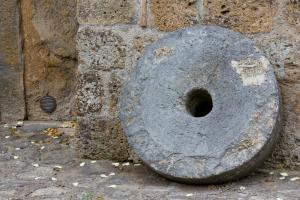
Something given to God to worship him. In the Old Testament, God's people offered food and animals to God. In the New Testament, Jesus offered himself as a sacrifice to God for us. Followers of Jesus serve God with their whole lives as an offering...

Nickname given by Ezekiel to the northern kingdom. It means "her tent" and probably refers to the Baal high places the northern kingdom built.

Nickname given by Ezekiel to the southern kingdom. It means "tent worshiper," a reference to the Baal worship of Judah.

This olive installation is located at the modern-day city of Maresha in southern Judea. Its appearance and location in a cave are typical of ancient presses. Oil installations were commonly placed in caves because the more moderate temperatures im...

The stone basin used to crush olives into pulp. A donkey pushed on a horizontal beam, which in turn rolled a millstone that crushed into a pulp ripe olives placed in a large, round basin. An olive crusher was often placed in a cave, where the mode...

Olive trees rarely reach 20 feet high. This ancient tree, with is gnarled trunk, is still very productive after 100 or more years of bearing olives. The root system of olive trees spreads wide to obtain the necessary moisture in Israel's relativel...

Olive oil was highly valued by the people of first-century Israel. They used it in food preparation and preservation, in medicine, and in cosmetics. Olive oil was also used to lubricate wheels and hinges. Its most important use, however, was proba...

Olive oil was a significant part of the daily lives of the Israelites in the first century. It was eaten in or with other food, used for skin care, used to fuel lamps, taken as medicine, and widely used in trade. It may also have been used as a lu...

The cultivation and harvesting of olives was essential to Galilee's first-century economy. A community olive processing installation included an olive crusher, which cracked the olives in order to produce an initial flow of oil, and an olive press...

The olive tree is one of the plants most frequently mentioned in the Bible. Scripture writers used olive tree imagery to describe Jesus' Jewish roots and the relationship of Jews and Gentiles.When an olive tree gets very old (often hundreds of yea...

The olive tree is known for its beauty (Hosea 14:6) partially because its large ancient trunk often has the look of a productive past. Furthermore, one side of the tree's leaves are light green and the other, a much lighter green, give the leaves ...

This bowl contains both ripe and unripe olives. The green olives, pickled or salted, are an important part of the daily diet. The black ones may be salted or pickled for eating; or more likely, they may be crushed and pressed for oil.

Large circular space in Greek theater used for chorus and actors.

Certainly not all people who lived in this fertile area were religious or even Jewish. But it is clear that most inhabitants of the sea's northwestern side were very religious;a fact supported by the many synagogues discovered there.Jesus conducte...

Ossuaries
Beginning shortly before Jesus' time, Jewish people began to practice reburials. After the flesh had decayed from the bones of a person who was buried, the bones were collected and placed in a small box, an ossuary, like the one shown he...

Called to Pursue Our First LoveAccording to Matthew 22:37-38, believers in Jesus the Messiah are to love the Lord with all their heart, soul and mind (strength). Yet, according to Romans 13:8-10, 1 John 2:9-11, 3:10-11, and other biblical passages...

Pagan GodsSurrounded by pagan neighbors, God's people often encountered people who worshiped other gods. Baal, Asherah, and other fertility gods played a significant role during Old Testament times.By Jesus' day, the baals were replaced by Greek a...

A slave attendant who accompanied students from wealthy families to school in order to tutor them in the lessons they received from the teacher in the gymnasium. (See Gal. 3:24).

Palace of a Great KingTHE ASSYRIAN EMPIREAssyria, located in Mesopotamia near the Euphrates River, was one of the great empires of the ancient world. Its history parallels much of the Old Testament. Known for their ruthlessness in battle and horri...

Courtyard of gymnasium used for exercise, wrestling, and boxing.

Name given to the Promised Land after the Second Jewish Revolt (AD 132-235). It is derived from the word Philistia and was used by the Romans to denigrate the Jews.

The Passover
For the Jewish people, Passover was more than a religious observance. It was the time of year when they celebrated liberation from Egyptian bondage.During Jesus' time, they also used this opportunity to express their longing for polit...

Greek and Roman god of the shepherds and goatherds, associated with fertility. Son of Hermes.'

A short story that is told to show how one thing is like another. Most of the parables in the Bible are stories used by Jesus. These parables teach us what the kingdom of God is like.






































